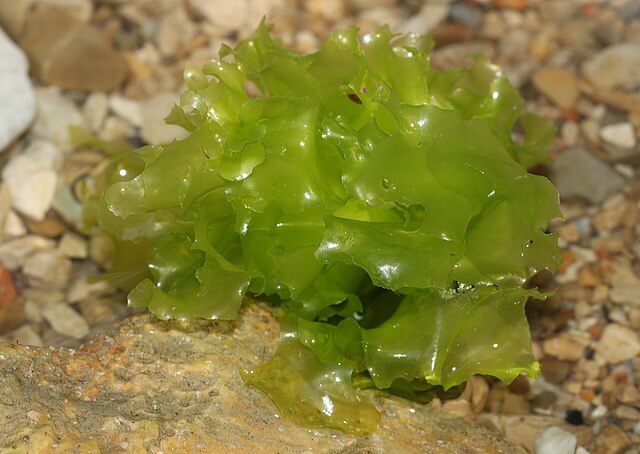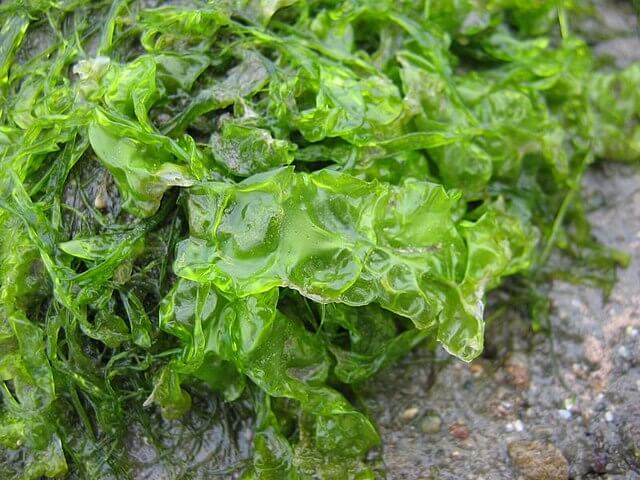One of the most commonly available seaweeds a forager can find is Sea Lettuce (Ulva lactuca). A member of the Ulvaceae family, sea lettuce has been used for centuries as food, medicine, and even as an additive to cosmetics. It is native to seas around the world and can be found in all temperate and tropical waters, even sometimes preferring brackish waters at river mouths. Sea lettuce can be found floating freely, suspended in ocean water, but it will eventually attach itself to reefs and rocky substrates in intertidal zones. While this alga can grow in semi-deep waters, it tends to stay in shallow areas to absorb as much sunlight as possible.

Sea lettuce is a green alga characterized by its semi-transparent, flat, ruffled fronds. It can grow a little over one and a half feet long and gets its common name from its similar appearance to lettuce leaves. While sea lettuce is a perennial alga, it tends to have a burst of growth in late summer, so many people forage for this seaweed in early fall. It grows readily on reefs and rocky shorelines, allowing foragers to fill baskets of sea lettuce at low tide, when it is easiest to reach.
Edibility & Culinary Use
The slimy fronds of sea lettuce can be eaten fresh and raw in salads. They can also be blanched for use in stir fries or dehydrated for use as a substitute for Nori. Sea lettuce is frequently added to soups and stews, but it can also be used as an herb or seasoning. When dried and powdered or flaked, sea lettuce can add a salty umami flavor to numerous dishes.
Medicinal Uses of Sea Lettuce
Like many edible seaweeds, sea lettuce is high in fiber and iodine, making it a wonderful supplement for the prevention and/or treatment of thyroid disorders. A distinct benefit of sea lettuce is its dense concentration of protein, iron, and vitamin B12—all nutrients that those following a vegan diet struggle to maintain at optimum levels. Medically, sea lettuce has been found to have promising antioxidant properties that can protect against coronary disease, and scientists are studying its compounds for potential use in various disease treatments.

Cautions
When foraging for sea lettuce, it is important to take note of Gutweed (Ulva Intestinalis), a close cousin of sea lettuce. While gutweed is perfectly edible (despite its less than appetizing scientific name), it is always up to you as a forager to ensure proper identification of wild plants you intend to ingest. Ingesting large amounts of iodine can worsen an undiagnosed or untreated thyroid disorder, so be sure to check with your doctor before adding sea lettuce as a staple of your diet. When foraging sea lettuce, check for large cities, runoff sites, or possible chemical contamination of the water the alga grows in. Also, as always, practice sustainable foraging by taking no more than one third of each plant and ensuring the holdfast stays intact and undisturbed.
Conclusion
Sea lettuce grows in abundance in many of the world’s oceans, and its various uses for humans make that good news. This alga has been prized by many cultures for its versatility in medicine, culinary arts, and the cosmetic industry. While sea lettuce provides plentiful vitamins and nutrients required for optimal health, it can interact poorly with certain medical conditions, so be sure to get the all clear from your doctor before adding it to your daily diet. If you walk nearly any beach on Earth, you’ll be able to search the shallow waters for the delicious and well-loved sea lettuce.
Many of our readers find that subscribing to Eat The Planet is the best way to make sure they don't miss any of our valuable information about wild edibles.
See our privacy policy for more information about ads on this site






